Arthur Hayes New Article: BTC Could Dip to $80,000 Before Starting a New Round of "Money Printing" Rally
Being bullish is correct, as over time, the money printer will surely go "brrr."
Original Article Title: Snow Forecast
Original Article Author: Arthur Hayes, Co-Founder of BitMEX
Original Article Translation: Bitpush News
It's that time of year again when I play amateur meteorologist. Concepts like La Niña and El Niño have entered my vocabulary.
Predicting the storm's direction is as important as the amount of snowfall, as it determines which slopes are suitable for skiing. I use my shallow knowledge of weather patterns to predict when autumn ends and winter begins in Hokkaido, Japan.
I discuss with other local ski enthusiasts when my dream powder season might start early. I no longer refresh my favorite cryptocurrency trading app frequently; now I spend most of my time on the Snow-Forecast app.

As the data points start coming in, I must decide when to hit the slopes with incomplete information. Sometimes it's not until the day before I strap on my snowboard that I know what the weather pattern will be.
A few snow seasons ago, when I arrived in mid-December, I found the mountain covered in dirt. Only one gondola was open, serving thousands of excited skiers. The queue was hours long to ski on a sparsely covered, flat beginner-to-intermediate slope. The next day, a heavy snowfall arrived, and I had one of the epic powder days in my favorite tree-lined ski area.
Bitcoin is a global fiat liquidity weather vane. Its trading depends on expectations of future fiat supply. Sometimes reality aligns with expectations, and sometimes it doesn't.
Money is politics. And the ever-changing political rhetoric influences the market's expectation of future dirty fiat supply.
Our imperfect leaders one day call for pumping their favorite supporters' assets with more massive, cheaper funds, and the next day call for measures to counter inflation that destroys ordinary people and their chances of re-election or perpetuating their autocratic rule.
As with science, in trading, holding firm beliefs but maintaining a flexible attitude is worthwhile.
After the disastrous failure of the "Great Tariff Day" in the United States on April 2, 2025, I once called for only rises and no falls.
I believe U.S. President Trump and his Treasury Secretary "Buffalo Bill" Bessent have learned their lesson and are no longer attempting to rapidly change the world's financial and trade operating systems.
In order to regain popularity, they will provide benefits to their supporters (individuals who hold a significant amount of real estate, stocks, and cryptocurrency financial assets), and these benefits are funded with printed money.
On April 9, Trump "Taco'd" (surrendered), announcing a tariff truce, turning a crisis that seemed like the beginning of a major depression into the best buying opportunity of the year. Bitcoin rose by 21%, and some altcoins (mainly Ethereum) also saw increases, with Bitcoin's dominance dropping from 63% to 59% to prove this.
However, recently, Bitcoin's implied dollar liquidity forecast has deteriorated. Since hitting an all-time high in early October, Bitcoin has fallen by 25%, with many altcoins hit harder than the blow capitalists received in the New York City mayoral election.
What has changed?
The Trump administration's rhetoric has not changed. Trump still criticizes the Fed for keeping rates too high. He and his deputies continue to talk about pumping up the real estate market through various means.
Most importantly, at every turning point, Trump has made concessions to China, postponing the mandatory reversal of the trade and financial imbalance between these two economic giants because the financial and political pain of such actions is unbearable for politicians who must face voters every two to four years.
What has not changed but is now given more weight by the market than political speeches is the contraction of dollar liquidity.

My dollar liquidity index (white line) has dropped by 10% since April 9, 2025, while Bitcoin (gold line) has risen by 12%. This divergence is partly due to the liquidity-positive comments released by the Trump administration. Part of the reason is that retail investors see inflows into Bitcoin ETFs and DAT mNAV premiums as evidence of institutional investors seeking Bitcoin exposure.
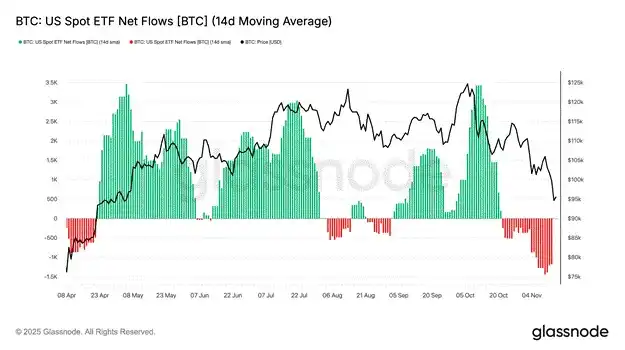
The narrative goes as follows: institutional investors are pouring into Bitcoin ETFs. As you can see, the net inflows from April to October provided continuous buying pressure for Bitcoin, despite a decrease in dollar liquidity. I must attach a warning to this chart. The largest ETF (BlackRock IBIT US) has its largest holders using the ETF as part of a basis trade; they are not bullish on Bitcoin.
They capitalize on the price difference by shorting Bitcoin futures contracts listed on CME and simultaneously buying ETFs.
This approach is capital efficient because their brokers typically allow them to use ETFs as collateral, securing their short futures positions.

These are the top five holders of IBIT US. They are large hedge funds or investment banks focused on proprietary trading, such as Goldman Sachs.
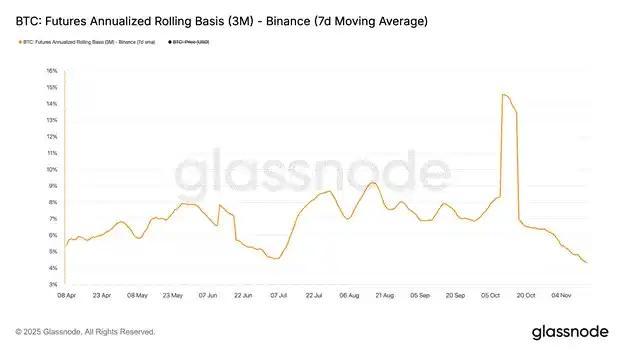
The chart above illustrates the annualized spread income these funds achieve by purchasing IBIT US and selling CME futures contracts.
While the exchange mentioned above is Binance, the CME's annualized spread is essentially the same. When the spread is significantly higher than the federal funds rate, hedge funds flock to trade, creating substantial and sustained net inflows into ETFs.
This has led to a misconception among those unaware of market microstructure, believing that institutional investors have a keen interest in holding Bitcoin exposure when, in reality, they are indifferent to Bitcoin entirely, merely playing in our sandbox to earn additional returns a few percentage points above the federal funds rate. As the spread decreases, they swiftly offload their positions. Recently, with the spread decreasing, ETF complexes have seen massive net outflows.
Now retail investors believe these institutional investors dislike Bitcoin, creating a negative feedback loop prompting them to sell, further reducing the spread, ultimately leading to more institutional investors selling ETFs.

Digital Asset Trust (DAT) companies offer institutional investors another way to gain Bitcoin exposure. Strategy (ticker: MSTR US) is the largest DAT holding Bitcoin. When its stock price exhibits a significant premium relative to its held Bitcoin (referred to as mNAV), the company can issue shares and other financing methods to acquire Bitcoin at a discounted price. As the premium decreases to a discount, Strategy's rate of acquiring Bitcoin slows down.

This is a Cumulative Holdings chart, not the rate of change of that variable, but you can see that as the Strategy's mNAV premium disappears, the growth rate of its holdings slows down.
Despite the USD liquidity contraction from April 9 to date, Bitcoin ETF inflows and DAT purchases have propelled Bitcoin higher. However, this situation has come to an end.
The basis is no longer attractive enough to sustain institutional investor buying of the ETF, and most DATs are trading at a discount to mNAV, with investors now also shunning these Bitcoin derivative securities. Without these flows to mask the negative liquidity condition, Bitcoin must fall to reflect current short-term concerns that either USD liquidity will shrink or not grow as fast as politicians have promised.
Present the Evidence...
Now is the time for Trump and Besant to present the evidence or shut up. Either they have the power to overshadow the Treasury Department over the Fed, create another real estate bubble, distribute more stimulus checks, etc., or they are a bunch of weak, powerless frauds.
Further complicating matters is that Blue Democrats have found (not surprisingly) that running on various affordability themes is a winning strategy. Whether the opposition can deliver on these promises, such as free bus passes, a plethora of rent-controlled apartments, and government-run grocery stores, is not the point. The point is that people want to be heard and can at least delude themselves into believing that someone in high office is looking out for them. The people don't want Trump and his army of "Make America Great Again" (MAGA) social media influencers to spin fake news to gloss over the inflation they see and feel every day.
For those with a longer-term view, these short-term hiccups in fiat money creation speed are irrelevant. If Red Republicans can't print enough money, the stock and bond markets will crash, forcing those doctrinaire in both parties to return to the devil-worshipping of money printing.
Trump is a savvy politician, much like former U.S. President Biden—who also faced similar resistance from the populace due to inflation stemming from COVID stimulus measures—he will publicly change course, blaming the Fed for the inflation plaguing the common folk. But fear not, Trump will not forget the wealthy asset holders who funded his campaign. "Buffalo Bill" Besant will receive strict orders to print money in ways ordinary people cannot fathom.
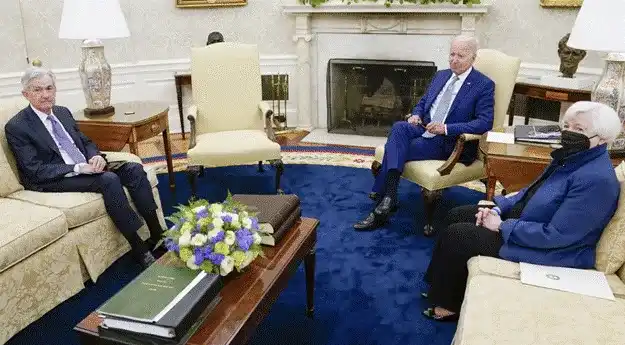
Do you remember this photo from 2022? Our favorite "Ass Kisser" Federal Reserve Chair Powell was then schooled by former President Biden (Slow Joe Biden) and U.S. Treasury Secretary Yellen (Bad Gurl Yellen). Biden explained to his supporters that Powell would crush inflation. Then, needing to boost the financial assets of those who got him into power, he instructed Yellen to undo all of Powell's rate hikes and balance sheet contractions at any cost.
Yellen issued more treasury bills than notes or bonds, from the third quarter of 2022 to the first quarter of 2025, siphoning off $2.5 trillion from the Fed's reverse repo program, thereby pumping up stocks, housing, gold, and cryptocurrency.
For the average voter — and some of the readers here — what I just wrote may be akin to gibberish, and that's precisely the point. The inflation you are experiencing is exactly what that politician who claims to care about easing the burden on the people has caused.
"Buffalo Bill" Benson must perform a similar kind of magic. I am one hundred percent confident he will design a similar outcome. He is one of the historical masters who understands the financial market plumbing and currency transactions.
What Is the Situation
The market setups for the second half of 2023 and 2025 are eerily similar. The debt ceiling battles end in midsummer (June 3, 2023, and July 4, 2025), forcing the Treasury to rebuild the General Account (TGA), thus siphoning liquidity out of the system.
2023:
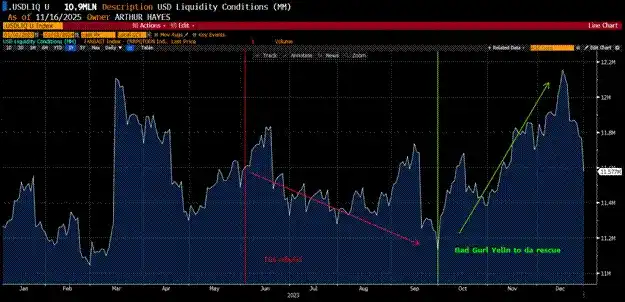
2025:

"Bad Girl" Yellen has pleased her boss. Whether "Buffalo Bill" Benson can find his "BB" and reshape the market by Bismarckian means to have red camp Republicans capture the votes of asset-holding voters in the 2026 midterms.
Whenever politicians listen too closely to the suffering majority under inflation, they verbally constrain the central bankers and Treasury officials who love to print money.
To dispel their idea of allowing credit contraction, the market presents a Hobson's Choice. Once investors realize that money printing is temporarily banned, stock and bond prices plummet swiftly, at which point politicians either print money to save the highly leveraged dirty fiat financial system that supports a more extensive economy, but this would lead to a renewed acceleration of inflation, or they allow credit contraction, which would ruin wealthy asset holders and lead to extensive unemployment as overleveraged businesses must cut output and jobs.
Typically, the latter is more politically palatable, as 1930s-style unemployment and financial distress are always electoral losers, whereas inflation is a silent killer that can be masked through subsidies to the poor funded by money printing.
Just as I have full confidence in Hokkaido's "snow-making machine," I one hundred percent believe that Trump and Bezos want their red camp Republicans to stay in power, so they will find a way to be tough on combating inflation while also printing the necessary money to continue propping up the Keynesian "fractional-reserve banking" scam in the current state of the American and global economy.
On the mountain, arriving too early can sometimes make you slide on mud. In the financial markets, before we return to the "Up Only" phase, as Nelly would say, the market must first "Drop Down and Get Their Eagle On" (kneel down and show posture). (By the way, they don't make music videos like they used to.)
The Bull Case
In contrast to my negative dollar liquidity thesis, the argument is that as the U.S. government resumes operations post-shutdown, the TGA will rapidly decrease by 100 to 150 billion dollars to reach the 850 billion dollar target, which will add liquidity to the system. Additionally, the Fed will stop tapering its balance sheet on December 1st and will promptly resume balance sheet expansion through quantitative easing (QE).
I was initially optimistic about risk assets post-shutdown. However, as I delved into the data, I noticed that approximately 1 trillion dollars of dollar liquidity has evaporated since July based on my index. Adding 150 billion dollars is great, but then what?
While several Fed officials have hinted at the need to resume quantitative easing to rebuild bank reserves and ensure the normal functioning of the money markets, it's just talk. We will only know they are serious when the Fed's "whisperer" - Nick Timiraos of The Wall Street Journal - announces the green light for QE. But we're not there yet. In the meantime, the Standing Repo Facility will be used to print money, in amounts of hundreds of billions of dollars, to ensure the money market can handle the massive issuance of government debt.
In theory, Bezos could bring the TGA down to zero. Unfortunately, because the Treasury must roll over hundreds of billions of dollars of Treasury bills each week, they need to maintain a large cash buffer in case of emergencies. They cannot afford the risk of a Treasury bill default at maturity, ruling out the possibility of immediately injecting the remaining 850 billion dollars into the financial markets.
The privatization of government-sponsored mortgage companies Fannie and Freddie will certainly happen, but not in the upcoming weeks. Banks will also fulfill their "duty" to lend to those manufacturing bombs, nuclear reactors, semiconductors, etc., but this will also occur over a longer time frame, and this credit will not immediately flow into the context of dollar liquidity.
The bull case is sound; over time, the money printer will surely go "brrr."
But first, the market must retrace the gains seen since April to better align with liquidity fundamentals.
Lastly, before I delve into Maelstrom's position, I do not subscribe to the notion that the "four-year cycle" holds true. Bitcoin and certain altcoins only achieve new all-time highs after the market has shaken out enough weak hands to accelerate the printing press.
Maelstrom's Position
Over the weekend, I increased our USD stablecoin exposure in anticipation of a cryptocurrency price drop. In the short term, I believe the only cryptocurrency that can outperform the adverse USD liquidity conditions is Zcash ($ZEC).
With the rise of artificial intelligence, Big Tech, and Big Government, privacy in most realms of the internet has vanished. Zcash and other privacy-centric cryptocurrencies utilizing zero-knowledge proof encryption are humanity's sole bulwark against this new reality. That's why figures like Balaji believe the privacy grand narrative will drive the crypto market for years to come.
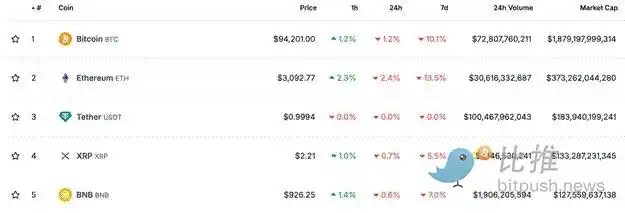
As a Satoshi disciple, the third, fourth, and fifth-largest cryptocurrencies being a USD derivative, a do-nothing coin on an idle chain, and CZ's centralized computer leave me feeling slighted.
If, 15 years from now, these are the largest cryptocurrencies after Bitcoin and Ethereum, what are we even doing?
I harbor no personal animosity towards Paolo, Garlinghouse, and CZ; they are maestros at creating value for their token holders. Founders, please take note. But Zcash or a similar privacy-focused cryptocurrency should rank just below Ethereum.
I believe the grassroots crypto community is awakening to the realization that endowing coins or tokens of this sort with such high valuations, while tacitly supporting something at odds with a decentralized future where we, as flesh-and-blood humans, retain agency against oppressive tech, governmental, and AI behemoths.
Hence, as we await for Powell to regain his printing press rhythm, Zcash or another privacy-focused cryptocurrency will enjoy sustained price appreciation.
Maelstrom is still a long-term bullish outlook for me. If I have to buy back at a higher price (just like I had to do earlier this year), that's okay. I proudly embrace my failures because I have fiat reserves on hand to boldly bet to win, making it truly worthwhile. Having liquidity in hand when the scenario reappears in April 2025 will determine your overall gains and losses more than having to give back your hard-earned small profits to the market due to trading losses.
Bitcoin dropped from $125,000 to a low of $90,000, while the S&P 500 Index and the Nasdaq 100 Index hovered near all-time highs, signaling to me that a credit event is brewing.
As I observe the decline in my USD liquidity index since July, I confirm this view.
If my view is correct, a 10% to 20% stock market correction, coupled with a close to 5% 10-year Treasury yield, will be enough to create a sense of urgency, prompting the Federal Reserve, Treasury Department, or another U.S. government entity to launch some form of money-printing scheme.
During this soft period, Bitcoin could easily fall to $80,000 to $85,000. If a broader risk-off market implosion occurs and the Fed and Treasury accelerate their money-printing shenanigans, Bitcoin could skyrocket to $200,000 or $250,000 by year-end.
I still believe China will reflate its currency. However, China will only pull the trigger once the U.S. ramps up dollar creation. Right or wrong, they want to show strength in the yuan against the dollar, which has prevented a significant increase in broad money supply. The sign is there: the People's Bank of China (PBOC) made a small purchase of government bonds for the first time since January. This is the beginning of China's quantitative easing. The dragon will awaken and splash baijiu onto the raging fire of the 2026 crypto bull market.
Before I set off to tango in beautiful Argentina, a final note about China: Beijing's displeasure with the U.S. "taking" a Chinese citizen suspected of involvement in fraudulent activity's Bitcoin is quite intriguing, isn't it? Apparently, the leadership sees Bitcoin as a valuable asset that should be held and protected by the Chinese nation or its people, not owned by the U.S. government.
If the leaders of the "two largest economic entities" in the world—both believe in the value of Bitcoin, what reason do you have not to be long-term bullish?
Disclaimer: The content of this article solely reflects the author's opinion and does not represent the platform in any capacity. This article is not intended to serve as a reference for making investment decisions.
You may also like
PhotonPay wins the Adam Smith Award for its innovative foreign exchange solutions, reshaping the global forex management landscape
How does PhotonPay collaborate with JPMorgan Kinexys to leverage blockchain technology for 24/7, automated global fund allocation?

Compliant privacy: What is the latest Ethereum privacy upgrade, Kohaku?
Vitalik once said, "If there is no privacy transformation, Ethereum will fail."

Danny Ryan: Wall Street needs decentralization more than you think, and Ethereum is the only answer
A former Ethereum Foundation researcher provided an in-depth analysis during the Devconnect ARG 2025 talk, explaining how eliminating counterparty risk and building L2 solutions could enable the management of 120 trillion in global assets.

Crypto Freeze: A Complete Technical Analysis of BTC and ETH

